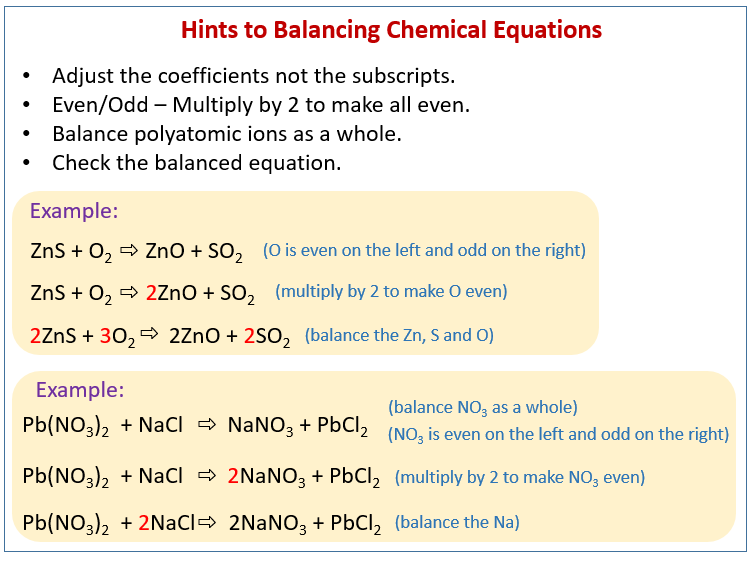Balancing Chemical Equations
In these lessons, we will look at some examples of balancing chemical equations containing polyatomic ions.
Related Pages
Writing Chemical Equations
Ionic Equations
More lessons on Chemistry
Atoms can neither be destroyed nor created during a simple chemical reaction. Therefore,
in a chemical reaction,
The sum of atoms before reaction = the sum of atoms after reaction
The following figure gives some hints on how to balance chemical equations. Scroll down the page for more examples and solutions.

General Rules for balancing chemical equations – Polyatomic Ions
Balancing chemical equations may require some trial and error. There are some general rules that could be helpful, but they may not work all the time.
Rule 1
Balancing chemical equations using the one’s and two’s technique
Rule 2
Balancing chemical equations using the two’s and three’s technique
Rule 3
Balancing chemical equations using the CHO technique
Rule 4
Balancing chemical equations using the even technique
Rule 5
Balancing chemical equations containing polyatomic ions
Case 1: If the polyatomic ion remains the same before and after the reaction, then treat it as “a single element” for ease of calculation. Try to start with the most complicated-looking group.
Example:
Balance the equation
Ca + HNO3 → H2 + Ca(NO3)2
Solution:
- The nitrate ion NO3 is unchanged before and after the reaction.
- Start with Ca(NO3)2 since it looks most complicated.
- There is one NO3 on the left and two on the left.
- Using the one’s and two’s technique, the equation is balanced by placing the coefficient of 2 for HNO3 Ca + 2HNO3 → H2 + Ca(NO3)2
- We test the other atoms and we find that we already have a balanced equation.
- Check to make sure that all coefficients are in the lowest-possible ratio
How to balance chemical equations containing polyatomic ions?
Example:
Balance the following equation:
Ca(NO3)2 + Na2S → CaS + NaNO3
Example:
Balance the following chemical equation:
Fe(NO3)3 + (NH4)2CO3 → Fe2(CO3)3 + NH4NO3
Example:
Balance the following chemical equation:
AgNO3 + K2CrO4 → Ag2CrO4 + KNO3
How to balance chemical equations containing polyatomic ions?
Example:
Balance the following chemical equation:
Pb(NO3)2 + NA2CO3 → PbCO3 + NaNO3
Case 2: If the polyatomic ion is changed after the reaction then it would be necessary to consider each atom individually.
Example:
Balance the chemical equation
Ba(OH)2 + H3PO4 → BaHPO4 + H2O
Solution:
- Use the CHO technique. Since we don’t have carbon, we could try to balance the hydrogen first.
- We have five hydrogen atoms on the left and three hydrogen atoms on the right.
- To balance the hydrogen, we can place the coefficient of 2 at H2O Ba(OH)2 + H3PO4 → BaHPO4 + 2H2O
- We test the other atoms and we find that we already have a balanced equation.
- Check to make sure that all coefficients are in the lowest-possible ratio.
How to balance chemical equations with polyatomic ions by rewriting H2O as H(OH)?
Examples:
Balance the following chemical equations:
Al4C3 + H2O → Al(OH)3 + CH4
C3H8 + O2 → CO2 + H2O
C6H6 + O2 → CO2 + H2O
Three helpful tips and tricks that make Balancing Chemical Equations easier
Tip #1: Put a star(*) next to any element appearing more than once on either the product or the reactant side; balance those elements last.
Tip #2: Recognize polyatomic groups that appear on both sides of the equation, and tea them as single items (e.g. don’t break SO4 into one sulfur and four oxygens)
Tip #3: If you have H and OH on one side and H2O on the other, it is helpful to rewrite H2) as H(OH).
Examples:
Balance the following chemical equations:
- C3H8 + O2 → CO2 + H2O
- Al2(SO4)3 + Ca(OH)2 → Al(OH)3 + CaSO4
- H3PO4 + NaOH → Na3PO4 + H2O
Try the free Mathway calculator and
problem solver below to practice various math topics. Try the given examples, or type in your own
problem and check your answer with the step-by-step explanations.

We welcome your feedback, comments and questions about this site or page. Please submit your feedback or enquiries via our Feedback page.